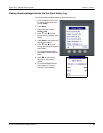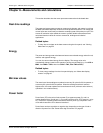
PowerLogic™ PM5100 series user guide Chapter 8—Measurements and calculations
© 2014 Schneider Electric All Rights Reserved 61
Chapter 8—Measurements and calculations
This section describes how the meter processes measured and calculated data.
Real-time readings
The power and energy meter measures currents and voltages, and reports in real time
the RMS (Root Mean Squared) values for all three phases and neutral. The voltage and
current inputs are continuously monitored at a sampling rate of 64 points per cycle. This
amount of resolution helps enable the meter to provide reliable measurements and
calculated electrical values for various commercial, buildings and industrial
applications.
Related topics
• To learn how to navigate to the data screens using the front panel, see “Viewing
Meter Data” on page 43.
Energy
The power and energy meter calculates and stores accumulated energy values for real,
reactive, and apparent energy.
You can view accumulated energy from the display. The energy value units
automatically change, based on the quantity of energy accumulated (e.g., from kWh to
MWh, from MWh to GWh, then from GWh to TWh, from TWh to PWh).
Related topics
• To view energy readings from the front panel display, see “Meter data display
screens” on page 43.
Min/max values
The meter’s real-time readings are updated once every 50 cycles for 50 Hz systems, or
once every 60 cycles for 60 Hz systems. When the readings reach their lowest or
highest value, the meter updates and saves these min/max (minimum and maximum)
quantities in non-volatile memory.
Power factor
Power factor (PF) is the ratio of active power (P) to apparent power (S), and is a
number between zero (0) and one (1). In a purely resistive circuit, PF is equal to 1 (unity
PF). Inductive or capacitive loads increase the reactive power (Q) component in the
circuit which causes the PF to become less than 1.
Power factor can have a positive or negative sign, depending on the type of load or
direction of power flow. See “Power factor sign convention” on page 62.


















